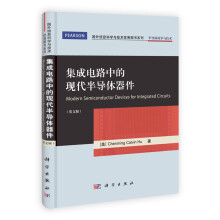集成电路中的现代半导体器件(影印版)

ContentsPreface1Electrons and Holes in Semiconductors 11.1 Silicon Crystal Structure 11.2 Bond Model of Electrons and Holes 41.3 Energy Band Model 81.4 Semiconductors, Insulators, and Conductors 111.5 Electrons and Holes 121.6 Density of States 151.7 Thermal Equilibrium and the Fermi Function 161.8 Electron and Hole Concentrations 191.9 General Theory of n and p 251.10 Carrier Concentrations at Extremely High and Low Temperatures 281.11 Chapter Summary 29PROBLEMS 30REFERENCES 33GENERAL REFERENCES 342Motion and Recombination of Electrons and Holes 352.1 Thermal Motion 352.2 Drift 382.3 Diffusion Current 462.4 Relation Between the Energy Diagram and V, 472.5 Einstein Relationship Between D and u 482.6 Electron-Hole Recombination 502.7 Thermal Generation 522.8 Quasi-Equilibrium and Quasi-Fermi Levels 522.9 Chapter Summary 54PROBLEMS 56REFERENCES 58GENERAL REFERENCES 583Device Fabrication Technology 593.1 Introduction to Device Fabrication 603.2 Oxidation of Silicon 613.3 Lithography 643.4 Pattern Transfer-Etching 683.5 Doping 703.6 Dopant Diffusion 733.7 Thin-Film Deposition 753.8 Interconnect-The Back-End Process 803.9 Testing, Assembly, and Qualification 823.10 Chapter Summary-A Device Fabrication Example 83PROBLEMS 85REFERENCES 87GENERAL REFERENCES 884PN and Metal-Semiconductor Junctions 89Part I: PN Junction 894.1 Building Blocks of the PN Junction Theory 904.2 Depletion-Layer Model 944.3 Reverse-Biased PN Junction 974.4 Capacitance-Voltage Characteristics 984.5 Junction Breakdown 1004.6 Carrier Injection Under Forward Bias-Quasi-Equilibrium Boundary Condition 1054.7 Current Continuity Equation 1074.8 Excess Carriers in Forward-Biased PN Junction 1094.9 PN Diode IV Characteristics 1124.10 Charge Storage 1154.11 Small-Signal Model of the Diode 116Part II: Application to Optoelectronic Devices 1174.12 Solar Cells 1174.13 Light-Emitting Diodes and Solid-State Lighting 1244.14 Diode Lasers 1284.15 Photodiodes 133Part III: Metal-Semiconductor Junction 1334.16 Schottky Barriers 1334.17 Thermionic Emission Theory 1374.18 Schottky Diodes 1384.19 Applications of Schottky Diodes 1404.20 Quantum Mechanical Tunneling 1414.21 Ohmic Contacts 1424.22 Chapter Summary 145PROBLEMS 148REFERENCES 156GENERAL REFERENCES 1565MOS Capacitor 1575.1 Flat-Band Condition and Flat-Band Voltage 1585.2 Surface Accumulation 1605.3 Surface Depletion 1615.4 Threshold Condition and Threshold Voltage 1625.5 Strong Inversion Beyond Threshold 1645.6 MOS C-V Characteristics 1685.7 Oxide Charge-A Modification to Vfb and Vt 1725.8 Poly-Si Gate Depletion-Effective Increasein Tox 1745.9 Inversion and Accumulation Charge-Layer Thicknesses and Quantum Mechanical Effect 1765.10 CCD Imagerand CMOS Imager 1795.11 Chapter Summary 184PROBLEMS 186REFERENCES 193GENERAL REFERENCES 1936MOS Transistor 1956.1 Introduction to the MOSFET 1956.2 Complementary MOS (CMOS) Technology 1986.3 Surface Mobilities and High-Mobility FETs 2006.4 MOSFET Vt, Body Effect, and Steep Retrograde Doping 2076.5 QINV in MOSFET 2096.6 Basic MOSFETIV Model 2106.7 CMOS Inverter-A Circuit Example 2146.8 Velocity Saturation 2196.9 MOSFETIV Model with Velocity Saturation 2206.10 Parasitic Source-Draln Resistance 2256.11 Extraction of the Series Resistance and the Effective Channel Length 2266.12 Velocity Overshoot and Source Velocity Limit 2286.13 Output Conductance 2296.14 High-Frequency Performance 2306.15 MOSFET Noises 2326.16 SRAM, DRAM, Nonvolatile (Flash) Memory Devices 2386.17 Chapter Summary 245PROBLEMS 247REFERENCES 256GENERAL REFERENCES 2577MOSFETs in ICs-Scaling, Leakage, and Other Topics 2597.1 Technology Scaling-For Cost, Speed, and Power Consumption 2597.2 Subthreshold Current-"Off" Is Not Totally "Off" 2637.3 Vt Roll-Off-Short-Channel MOSFETs Leak More 2667.4 Reducing Gate-Insulator Electrical Thickness and Tunneling Leakage 2707.5 How to Reduce Wdep 2727.6 Shallow Junction and Metal Source/Draln MOSFET 2747.7 Trade-Off Between /on and /off and Design for Manufacturing 2767.8 Ultra-Thin-Body SoI and Multigate MOSFETs 2777.9 Output Conductance 2827.10 Device and Process Simulation 2837.11 MOSFET Compact Model for Circuit Simulation 2847.12 Chapter Summary 285PROBLEMS 286REFERENCES 288GENERAL REFERENCES 2898Bipolar Transistor 2918.1 Introduction to the BJT 2918.2 Collector Current 2938.3 Base Current 2978.4 Current Galn 2988.5 Base-Width Modulation by Collector Voltage 3028.6 Ebers-Moll Model 3048.7 Transit Time and Charge Stor
胡正明(Chenming Calvin Hu),IEEE Fellow、美国工程院院士、中国科学院外籍院士,多年从事半导体器件与集成电路领域的前沿性研究工作,对半导体器件的开发及未来的微型化做出了重大贡献。2001年至2004年在全球规模最大的专业集成电路制造服务公司——台积电担任CTO,1997年因在元件可靠性方面的贡献而获得IEEE电子元件奖(Jack Morton Award),2002年因发展了第一个国际标准的晶体管电路仿真模型而获得IEEE固态电路奖,2009年因在器件物理和尺寸方面的杰出贡献而获得西泽润一奖(Jun-ichi Nishizawa Medal),发表论文800余篇,拥有美国专利100余项,由他指导发表的博士论文60余篇。同时,还获得了美国加帅0大学伯克利分校教育方面的最高奖项——伯克利杰出教育奖。
《集成电路中的现代半导体器件(影印版)》主要介绍与集成电路相关的主流半导体器件的基本原理,包括PN结二极管、MOSFET器件和双极型晶体管(BJT),同时介绍了与这些半导体器件相关的集成工艺制造技术。《集成电路中的现代半导体器件(影印版)》作者是美国工程院院士、中国科学院外籍院士,多年从事半导体器件与集成电路领域的前沿性研究工作。《集成电路中的现代半导体器件(影印版)》内容简明扼要,重点突出,深度掌握适宜,讲解深入浅出,理论联系实际。
比价列表
公众号、微信群
 缺书网
缺书网微信公众号
 扫码进群
扫码进群实时获取购书优惠





